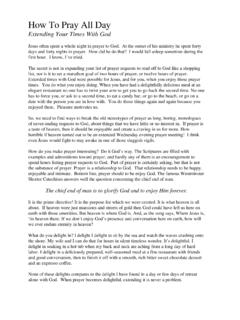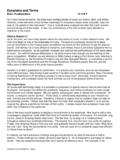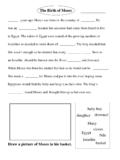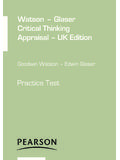Transcription of An Interview with Beverly Cleary
1 An Interview with Beverly Cleary HarperCollins: What inspired you to create the character of Ramona? Beverly Cleary : Well, she was really an accidental character. When I was writing Henry Huggins, it occurred to me that all the children appeared to be only children. I thought I should put somebody else in, so I was starting to put in a little sister and someone called out to a neighbor who was named Ramona, so I just called Beezus s little sister Ramona. She has continued to grow in the books, somewhat to my surprise. I hadn t really intended to write so much about her, but there she was. She kept hanging around, and I kept having Ramona ideas. HC: How do you approach the writing of a Ramona book? BC: Oh, very messily. I usually start with a couple of ideas, not necessarily at the beginning of the book, and I just write.
2 Sometimes I have to go back and figure out how a character got to a particular point. In Ramona and Her Father, I wrote the part about the sheep costume last. Actually, I was asked to write a Christmas story about Ramona for one of the women s magazines. I did this, and called it Ramona and the Three Wise Persons. But in writing this story, I was thinking how Ramona got to the point where she was wearing a sheep costume made from old pajamas. So after that story was published, I wrote how she got to that point. So in this case, I wrote the last chapter first. Of course this is against everything people are taught about writing, but I don t believe that outlining works for fiction because if you have it all worked out, it becomes boring. So I just write. I really enjoy revising more than writing.
3 I love to cross things out and cut a page down to one paragraph. I think sometimes beginning writers are so impressed with what they have written that they can t really judge it. I know I wouldn t want to see anything published as I wrote it initially because it changes so much in the writing. I revise until a little light bulb clicks off and I know it s done. I just know when it feels right. My first editor told me I was an intuitive writer. I hadn t really thought about myself that way, but I guess she was right. HC: Were you taught creative writing in school? BC: Oh no, goodness no. I didn t have anything like creative writing until I was in the eighth grade, when the Portland School System changed to the platoon system, and we had some younger teachers who were more creative than those I d had before.
4 I m surprised sometimes that I ve written anything. We were always supposed to produce things exactly the same, but these younger teachers encouraged creativity. And the school librarian took a special interest in me. She encouraged me by saying that someday I should write for children. It seemed like a good idea. We had a class called auditorium in which we put on plays or got up and gave current events. I wrote a play about Sacajawea for this class. We had to stand on the stage and whisper so the teacher could hear us in the back of the auditorium. I wish children today had a class like this. As I listen to my grandchildren in their school programs, I notice children don t speak properly they drop the ends of their sentences. HC: There is a 13-year gap between the time you wrote Beezus and Ramona and its first sequel, Ramona the Pest.
5 What made you decide to revisit Ramona? BC: Oh, I kept thinking about her. She was around in Ribsy and in several of the other books about Henry Huggins and his friends, and my editor had wanted me to write a book about her for years. But Ramona would be in kindergarten, and I hadn t gone to kindergarten and didn t know anything about kindergarten. But as the years passed, I had twins who went to kindergarten. Twins are a great advantage because they compare notes at the dinner table. I learned a lot about kindergarten that year and felt I had enough knowledge to write about it. Now the moment was right, so I did it. HC: You gracefully leap from the fifties to the sixties time period without skipping a beat in Ramona s life. Did you make conscious decisions to help you accomplish this stylistic feat?
6 BC: No, I don t really think of my stories as taking place in any particular time. However, they do take place in a real neighborhood in which I grew up and which I still visit. It s really a remarkable neighborhood. It s changed very little since I lived there. It s a very stable place, and I often think about it. I think part of it was that when the houses were built, there was lots of lumber in Oregon, and they re very well built houses. They re not anything lavish; they re just solid houses. It s what the real estate people call a pride-of-ownership neighborhood. I think about this place as I write, but the children in my stories now wear pants if they want to that wouldn t have been permitted in my day but those are minor things. HC: Ramona has been artistically rendered in various art or media forms, including drawing, sculpture, dramatic presentations, and television productions.
7 How do you think Ramona translates into these other media? BC: Well, when I agreed to the scripts of the little theater productions, I had not realized that they would ever use adults to perform the parts of children. That dismays me because the theater that did this originally used children. It was a children s theater, and I thought this would be for children s theaters in which children acted. I m really a little surprised to see Ramona being a small adult. I ve only seen productions done in Portland, so I don t really know how they turn out elsewhere. There was a production put on recently in New York, and someone sent me a review which was very favorable, but I don t really know if they were children acting in this production or not. Now about the artwork in the books when Louis Darling died, it was very had to find somebody to take his place.
8 But I m very happy with Alan Tiegreen, and I finally have said let s have one artist do all my covers. So I think that s the way it s going to be from now on. The publishers consult me on every little detail, and I don t know that I m always the best judge, but they do ask. I won t let go of the rights for television productions unless I have script approval. There have been companies that have wanted the movie rights to Ramona, but they won t let me have script approval, and so I say no. I did have script approval for the television productions of the Ramona series, which was done by an educational film company. I did a lot of rewriting on the scripts, and I think they turned out as well as can be expected when you consider all the problems involved. They ran out of money and so the whole thing had to be moved to Canada.
9 Fortunately, Cecilie Truit and the director from Lancet Media went there and stayed with the whole production. I thought Sarah Polley was a good little actress, a real little professional. She has recently been singled out for praise due to her performance in the movie The Sweet Hereafter. HC: Would you please tell us a little about the Beverly Cleary Sculpture Garden for Children erected in Portland, Oregon s Grant Park? BC: Oh, well, I was very honored and pleased and very touched at how hard they worked to raise the money. School children would bring coffee cans full of pennies and nickels. It was great fun to go up for the dedication. People tell me that there is lots of daily activity around it. People sit and look at it. Dogs come and look at Ribsy; they get their hackles up, and then they approach his figure.
10 There was a competition for the selection of the artist. I was asked to choose the winner, and I chose Lee Hunt. She loves the stories and her proposal was quite conscientious. She looked up children s clothing from the 1950s and tried to select things that wouldn t date. She went out and photographed the site and did a lot of things that showed she was truly interested. She worked very hard, and I think she captured the characters quite well as sculptures. She also has some Ramona sculptures in the St. Paul Library Children s Room in Minneapolis, I believe, and some of her Ramona busts are in the public library in Gresham, Oregon. She has been able to capture Ramona s different expressions. In one of them, Ramona is just mad. In another she is smiling. Don t miss any of the adventures of Ramona Quimby!









